The Pink Jersey Is up for Grabs as the Giro Enters Its Final Week
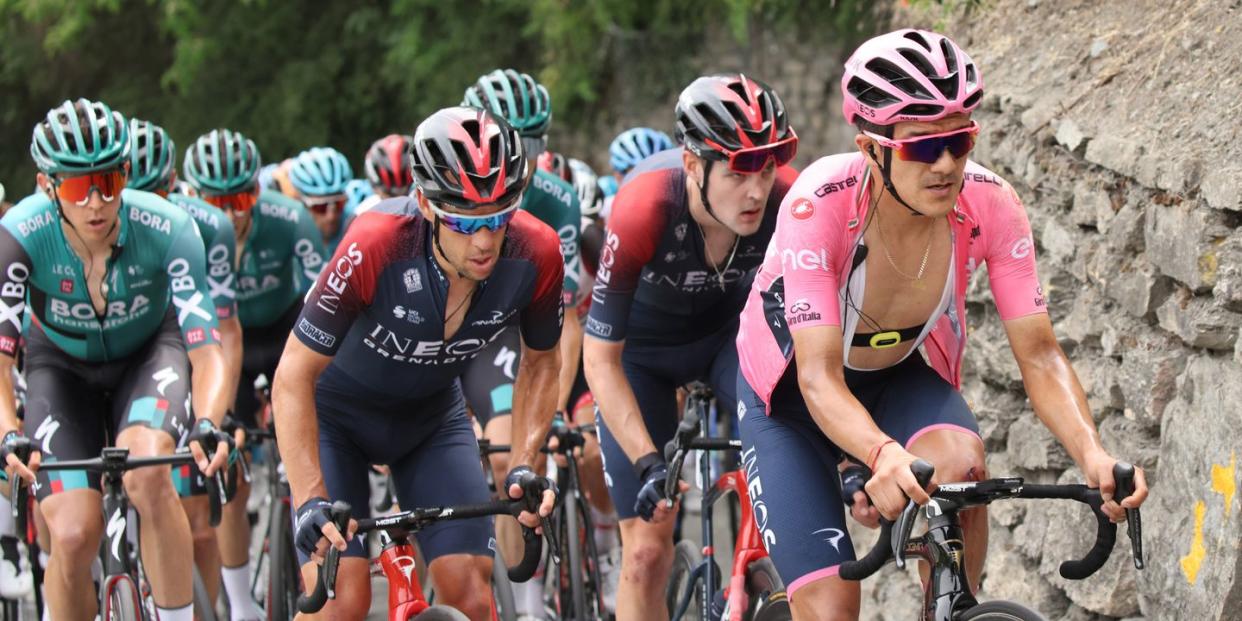
- Oops!Something went wrong.Please try again later.
- Oops!Something went wrong.Please try again later.
The second “week” of the 2022 Tour of Italy ended on Sunday with Ecuador's Richard Carapaz (INEOS Grenadiers) wearing the pink jersey as the leader of the race’s General Classification. But with only seven seconds between Carapaz and the Giro d’Italia’s next-best rider, Australia’s Jai Hindley (BORA-hansgrohe), and two more contenders within a minute of the Maglia Rosa, Portugal’s João Almeida (UAE Team Emirates) and Spain’s Mikel Landa (Bahrain-Victorious), the race to win the season’s first “Grand Tour” is far from over.
Here’s everything you need to know as the race gets ready to enter its third and final week.
Who’s Winning?
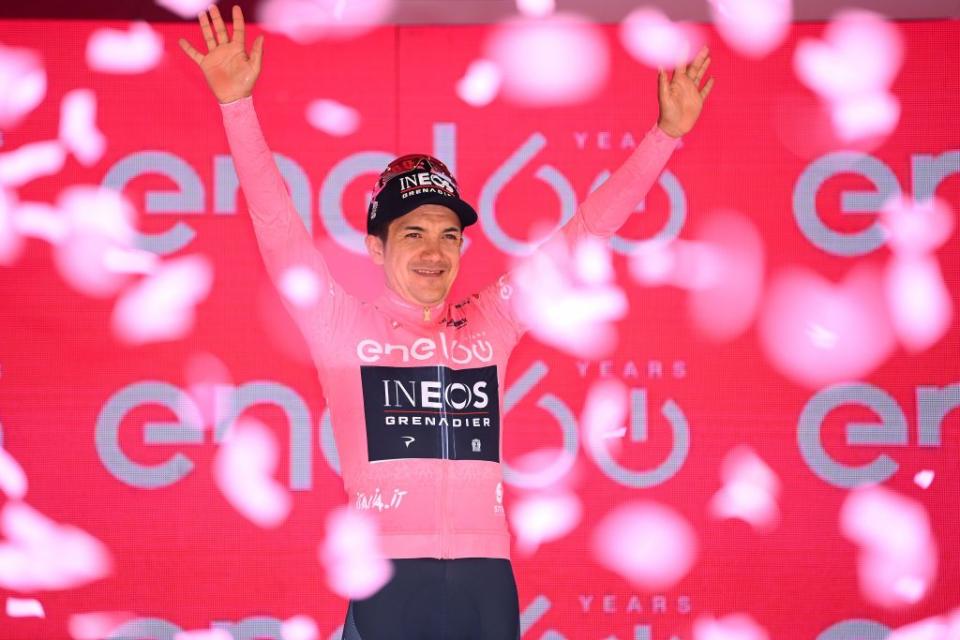
Three years after winning the 2019 Giro d’Italia for Movistar, Carapaz is once again in pink as the Giro’s overall leader. The 28-year-old took the jersey from Spain’s Juan Pedro López (Trek-Segafredo) after finishing third on Stage 14. The young Spaniard fought valiantly, wearing the jersey for 10 days before finally handing it over during Saturday’s short, intense stage through the hills around Torino.
Carapaz heads into the Giro’s final rest day with a seven-second lead over Hindley, with Almeida 30 seconds down in third. Landa’s only 59 seconds behind Carapaz and looks poised for his best Grand Tour finish in years.
In terms of the Giro’s other competitions, France’s Arnaud Démare (Groupama-FDJ) still wears the Maglia Ciclamino (“cyclamen jersey”) as the leader of the Giro’s Points Classification, while the Netherlands’ Koen Bouwman (Jumbo-Visma) wears the Maglia Azzurra (“blue jersey”) as the new leader of the King of the Mountains Classification. Almeida wears the Maglia Bianca (“white jersey”) as the Giro’s Best Young Rider.
What Happened?
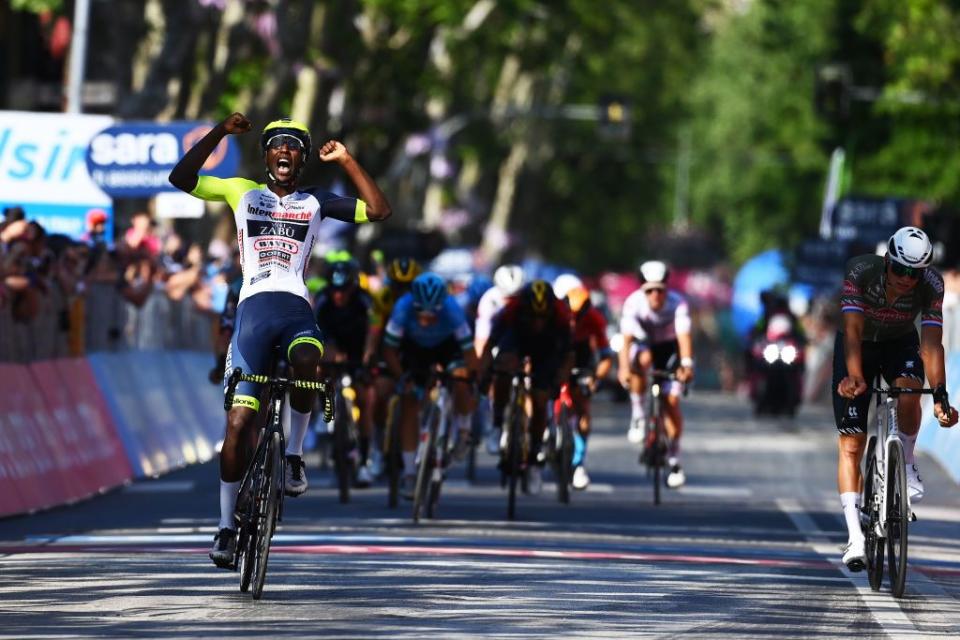
The second “week” of 105th Giro d’Italia opened with a historic stage win for Eritrea’s Biniam Girmay (Intermarché-Wanty-Gobert Matériaux), who won Stage 10 in Jesi. Unfortunately, the Eritrean was forced to abandon the race the next morning after injuring his eye while trying to pop the cork on a bottle of Prosecco on the stage winner’s podium.
After going winless for 10 stages, Italians then won the next two, with Alberto Dainese (Team DSM) surprising the Giro’s other sprinters to win Stage 11 in Reggio Emilia and Stefano Oldani (Alpecin-Fenix) winning Stage 12 in Genoa from a breakaway.
Demare won his third stage of the race on Stage 13, giving the Frenchman a nearly insurmountable lead in the Giro’s Points Classification—assuming he survives the Giro’s mountainous final week. López did enough on these four stages to maintain his lead in the Giro’s General Classification, giving the Spaniard another four days to enjoy wearing the Maglia Rosa.
Stage 13 also saw one of the prerace favorites, Romain Bardet (Team DSM) abandon the Giro due to illness. Bardet was sitting at fourth in the GC, 14 seconds back of the lead, at the time of his abandonment.
But the second week was defined by Saturday’s Stage 14, an explosive stage consisting of two circuits around Torino, each featuring two Category 2 climbs. At only 147km, the riders were unafraid of making the race hard from the outset, and by the end of the day the gaps were huge: Heading into the stage, the Giro’s top-10 riders were separated by only 1:23, by the time the dust settled, they were spread over 9:06.
Great Britain’s Simon Yates won the stage, saving face after losing more than 11 minutes on last Sunday’s summit finish on the Blockhaus. Behind him, Hindley outsprinted Carapaz to finish second, with the Ecuadorian taking the pink jersey by seven seconds over the Aussie. López fought valiantly, but in the end didn’t have enough to hang with the Giro’s true contenders. He lost 4:25 and fell to ninth overall.
On Stage 15, one day after losing the pink jersey, Trek-Segafredo rebounded with Italy’s Giulio Ciccone winning the Alpine stage to Cogne. After such an intense stage the day before, the Giro’s remaining GC contenders seemed content to ride a steady tempo behind, letting the breakaway from which Ciccone ultimately emerged gain a large advantage. The apparent “cease fire” continued all the way to the finish line, where the Giro’s heads of state were happy to head into the race’s final rest day unscathed.
What Did We Learn?
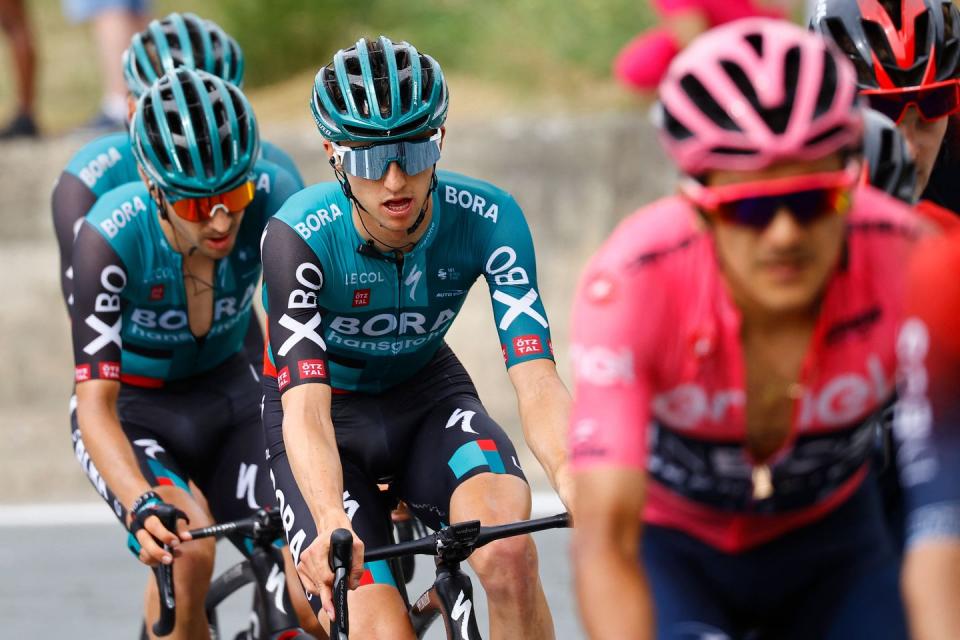
Carapaz, an experienced Grand Tour contender, is the leader in the clubhouse, and has the benefit of riding for the race’s best overall team.
But Hindley shouldn’t be discounted. The Australian’s BORA-hansgrohe squad has displayed some impressive depth of its own, and as they showed on Stage 14 isn’t intimidated by INEOS. And Hindley’s no stranger to the pressure that comes with trying to win a Grand Tour heading into the race’s final week. He was leading the Giro heading into the race’s final stage back in 2020, only to lose the pink jersey in the final individual time trial.
If the Giro does come down to the final stage, the bad news for Hindley is that Carapaz has beaten the Aussie seven out of the eight times the two have gone head-to-head in an individual time trial, including twice so far this year. So if Hindley’s to win the race overall, he’ll need to go into the final stage with a lead of at least 30 seconds over the Ecuadorian–possibly more.
Behind Carapaz and Hindley, Almeida looks poised for a podium finish—his goal before the race began in Budapest over two weeks ago. He’ll likely ride defensively over the final four mountain stages, hoping that–as one of the better time trialists among the Giro’s GC contenders–he can afford to lose a little bit of time in the mountains and still stand on the final podium in Verona.
The biggest threats to Carapaz and Hindley will likely come from Landa, who’s ridden a near-perfect race so far and has a shot to score his first podium finish in a Grand Tour since finishing third in the Giro in 2015. His teammate, Spain’s Pello Bilbao, sits sixth overall and the two can play that to their advantage in the final week. Look for them to be two of the Giro’s biggest animators in the mountains still to come.
And last but not least, there’s Italy’s Vincenzo Nibali (Astana). One of only seven riders in history to have won all three of cycling’s Grand Tours, Nibali’s Giro seemed over after he lost more than two minutes to the Giro’s other contenders on Mt. Etna at the end of Stage 4. The next day, at the end of Stage 5 in Messina (his hometown), he announced that he’s retiring at the end of the season.
But the “Shark” bit back, getting stronger through the rest of the first week and into the second. The only rider able to hang with Carapaz and Hindley on Stage 14, the 37-year-old now sits eighth overall, 2:58 away from the pink jersey. That’s a lot of ground to make up, but Nibali’s not one to ride conservatively. He overcame a gap of 4:43 to win the Giro in 2016, and will certainly do everything he can to end his final Giro with a flourish.
What’s Next?
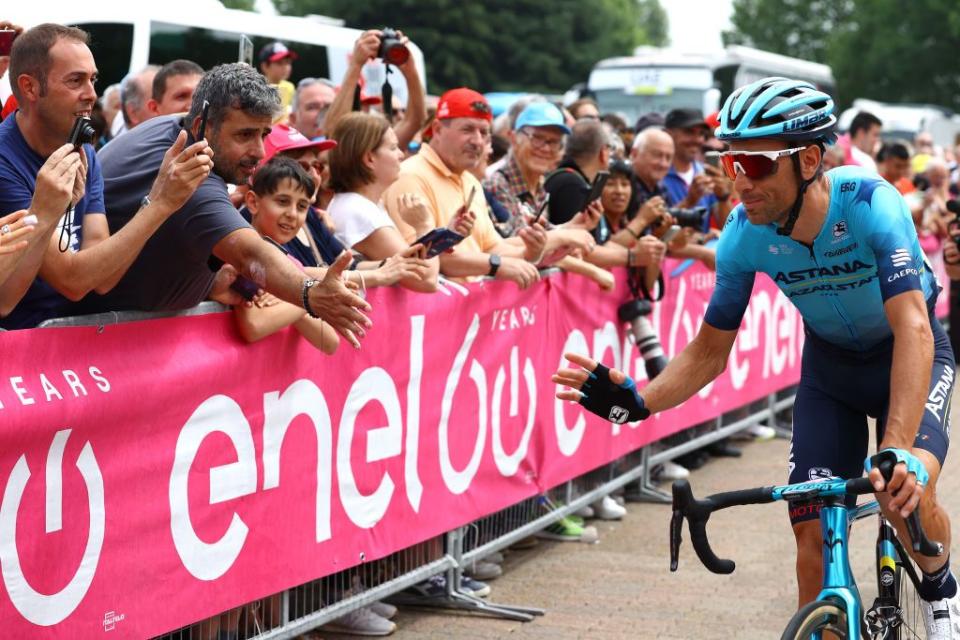
The Giro’s final week opens on Tuesday with one of the race’s hardest stages: a 202km ride through the Alps that features four climbs including the Mortirolo, one of the most famous climbs in Giro history. With over 5,000 meters of elevation gain, Stage 16 won’t give the riders much time to readjust to racing after Monday’s rest day. That’s why savvy riders will likely go for a long ride on their day “off” so as to maintain the routine their bodies have grown accustomed to over the past two weeks.
More climbing awaits on Stage 17, a stage that’s essentially two days in one: the first half begins uphill but then descends for 70km through valley roads. The second half brings three categorized climbs, including the final climb to Monterovere, where a narrow road and tunnels carved into the rock should make for some spectacular scenery. The climb summits just 10km from the finish in Lavarone.
Thursday’s Stage 18 should serve as a rest day for all but the Giro’s remaining field sprinters. The road travels through the valley from Borgo Valsunga to the Venetian Plain, where a flat finish in Treviso awaits. Expect many of the Giro’s sprinters to head home from here, especially with Demare having a stranglehold on the Maglia Ciclamino.
Stage 19 heads back to the mountains, with a short trip into Slovenia before a summit finish on the Category 2 climb to the Santuario di Castelmonte. This late in the race, the outcome is anyone’s guess. A breakaway could go the distance, but behind them, with only one day left in the mountains before Sunday’s final time trial, the battle to win the Giro should continue.
Stage 20 is the true “Queen Stage” of the 2022 Giro d’Italia, a classic mountain stage through the Dolomites. Beginning in Belluno, the 168km stage features three Category 1 ascents including the Passo San Pellegrino (18.5km at 6.2 percent), the Passo Pordoi (11.8km at 6.8 percent), and the Passo Fedaia (14km at 7.6 percent). The summits of the final two climbs sit above 2,000 meters, with the Pordoi (2239 meters) being named the “Cima Coppi” as the highest climb in the entire race.
There’s little strategy to riding a stage like this: riders will need to be at their best to handle both the altitude and the attacks from their rivals. The stage also offers the perfect opportunity for a rider like Nibali to try and turn the race on its head with a long-range attack.
Any remaining loose ends will be settled on Stage 21, a 17.4km individual time trial in Verona. The stage is long enough to generate some serious time gaps and riders will need to pace themselves up and over the Category 4 Torricella Massimiliana ascent.
With so many mountains before it–and so few skilled time trialists among the Giro’s remaining GC contenders–it’s hard to see this stage determining the overall winner. But the Giro has come down to its final stage twice in the last five years: the Netherlands’s Tom Dumoulin overtook Colombia’s Nairo Quintana to win the Giro in 2017, and Great Britain’s Tao Geoghegan Hart hauled back Hindley to win the race in 2020.
By the time it’s all said and done, Carapaz may have done enough to win his second Giro d’Italia, the fourth in five years for INEOS. But Nibali will have the fans of his home country on his side every step of the way.
You Might Also Like

